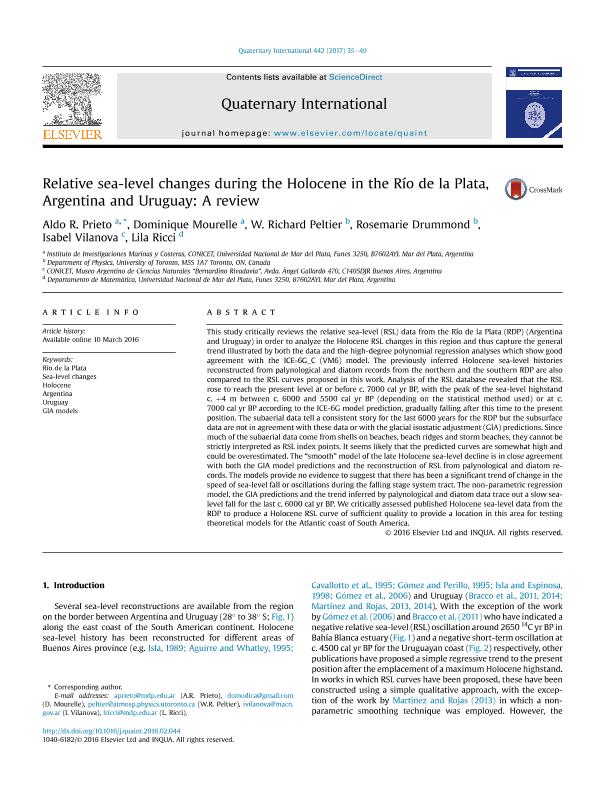Mostrar el registro sencillo del ítem
dc.contributor.author
Prieto, Aldo Raul

dc.contributor.author
Mourelle Civano, Dominique

dc.contributor.author
Peltier, W. Richard
dc.contributor.author
Drummond, Rosemarie
dc.contributor.author
Vilanova, Isabel

dc.contributor.author
Ricci, Lila

dc.date.available
2018-05-30T13:29:20Z
dc.date.issued
2017-06
dc.identifier.citation
Prieto, Aldo Raul; Mourelle Civano, Dominique; Peltier, W. Richard; Drummond, Rosemarie; Vilanova, Isabel; et al.; Relative sea-level changes during the Holocene in the Río de la Plata, Argentina and Uruguay: A review; Pergamon-Elsevier Science Ltd; Quaternary International; 442; 6-2017; 35-49
dc.identifier.issn
1040-6182
dc.identifier.uri
http://hdl.handle.net/11336/46574
dc.description.abstract
This study critically reviews the relative sea-level (RSL) data from the Río de la Plata (RDP) (Argentina and Uruguay) in order to analyze the Holocene RSL changes in this region and thus capture the general trend illustrated by both the data and the high-degree polynomial regression analyses which show good agreement with the ICE-6G_C (VM6) model. The previously inferred Holocene sea-level histories reconstructed from palynological and diatom records from the northern and the southern RDP are also compared to the RSL curves proposed in this work. Analysis of the RSL database revealed that the RSL rose to reach the present level at or before c. 7000 cal yr BP, with the peak of the sea-level highstand c. +4 m between c. 6000 and 5500 cal yr BP (depending on the statistical method used) or at c. 7000 cal yr BP according to the ICE-6G model prediction, gradually falling after this time to the present position. The subaerial data tell a consistent story for the last 6000 years for the RDP but the subsurface data are not in agreement with these data or with the glacial isostatic adjustment (GIA) predictions. Since much of the subaerial data come from shells on beaches, beach ridges and storm beaches, they cannot be strictly interpreted as RSL index points. It seems likely that the predicted curves are somewhat high and could be overestimated. The “smooth” model of the late Holocene sea-level decline is in close agreement with both the GIA model predictions and the reconstruction of RSL from palynological and diatom records. The models provide no evidence to suggest that there has been a significant trend of change in the speed of sea-level fall or oscillations during the falling stage system tract. The non-parametric regression model, the GIA predictions and the trend inferred by palynological and diatom data trace out a slow sea-level fall for the last c. 6000 cal yr BP. We critically assessed published Holocene sea-level data from the RDP to produce a Holocene RSL curve of sufficient quality to provide a location in this area for testing theoretical models for the Atlantic coast of South America.
dc.format
application/pdf
dc.language.iso
eng
dc.publisher
Pergamon-Elsevier Science Ltd

dc.rights
info:eu-repo/semantics/openAccess
dc.rights.uri
https://creativecommons.org/licenses/by-nc-sa/2.5/ar/
dc.subject
ARGENTINA
dc.subject
GIA MODELS
dc.subject
HOLOCENE
dc.subject
RÍO DE LA PLATA
dc.subject
SEA-LEVEL CHANGES
dc.subject
URUGUAY
dc.subject.classification
Meteorología y Ciencias Atmosféricas

dc.subject.classification
Ciencias de la Tierra y relacionadas con el Medio Ambiente

dc.subject.classification
CIENCIAS NATURALES Y EXACTAS

dc.title
Relative sea-level changes during the Holocene in the Río de la Plata, Argentina and Uruguay: A review
dc.type
info:eu-repo/semantics/article
dc.type
info:ar-repo/semantics/artículo
dc.type
info:eu-repo/semantics/publishedVersion
dc.date.updated
2018-05-24T14:31:46Z
dc.journal.volume
442
dc.journal.pagination
35-49
dc.journal.pais
Estados Unidos

dc.journal.ciudad
New York
dc.description.fil
Fil: Prieto, Aldo Raul. Consejo Nacional de Investigaciones Científicas y Técnicas. Centro Científico Tecnológico Conicet - Mar del Plata. Instituto de Investigaciones Marinas y Costeras. Universidad Nacional de Mar del Plata. Facultad de Ciencia Exactas y Naturales. Instituto de Investigaciones Marinas y Costeras; Argentina
dc.description.fil
Fil: Mourelle Civano, Dominique. Consejo Nacional de Investigaciones Científicas y Técnicas. Centro Científico Tecnológico Conicet - Mar del Plata. Instituto de Investigaciones Marinas y Costeras. Universidad Nacional de Mar del Plata. Facultad de Ciencia Exactas y Naturales. Instituto de Investigaciones Marinas y Costeras; Argentina
dc.description.fil
Fil: Peltier, W. Richard. University of Toronto; Canadá
dc.description.fil
Fil: Drummond, Rosemarie. University of Toronto; Canadá
dc.description.fil
Fil: Vilanova, Isabel. Consejo Nacional de Investigaciones Científicas y Técnicas. Oficina de Coordinación Administrativa Parque Centenario. Museo Argentino de Ciencias Naturales "Bernardino Rivadavia"; Argentina
dc.description.fil
Fil: Ricci, Lila. Universidad Nacional de Mar del Plata; Argentina
dc.journal.title
Quaternary International

dc.relation.alternativeid
info:eu-repo/semantics/altIdentifier/doi/https://dx.doi.org/10.1016/j.quaint.2016.02.044
dc.relation.alternativeid
info:eu-repo/semantics/altIdentifier/url/https://www.sciencedirect.com/science/article/pii/S104061821530104X
Archivos asociados
